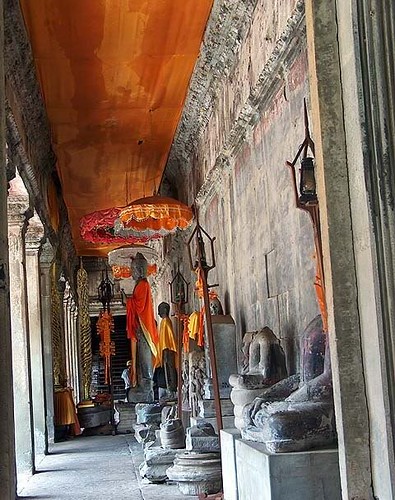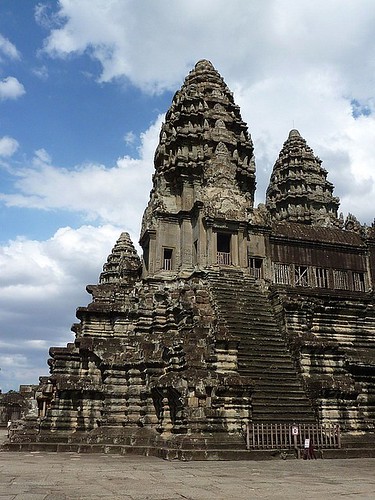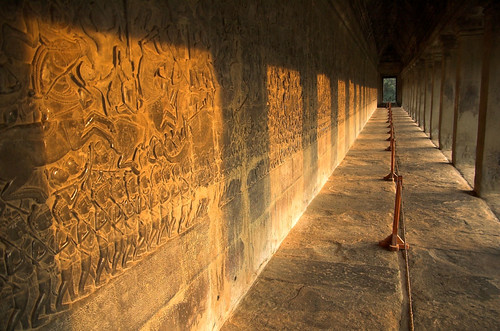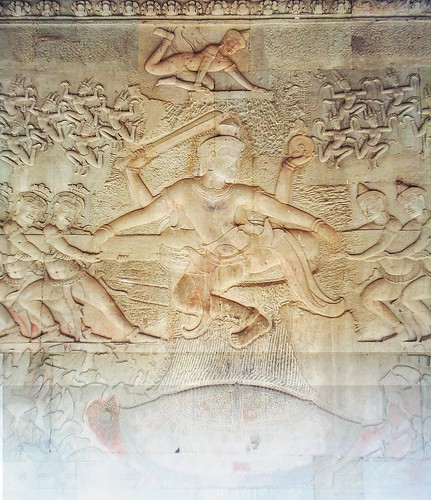Introduction
Angkor derives from a Sanskrit word meaning ‘holy city’; ‘Wat’ in Khmer means ‘temple’. Angkor Wat, located 5.5 km north of the modern town of Siem Reap in northeast Cambodia represents a whole complex of wonderful temples and stonemasonry and artwork throughout this area. It is a UNESCO world heritage site and is one of the most important archaeological sites in South-East Asia besides being the single largest religious structure in the world, and surely one of the world’s wonders of art and architecture.

The temples of Angkor were built by the Khmer civilization between 802 and 1220 AD. From Angkor the Khmer kings ruled over a vast domain that reached from Vietnam to China to the Bay of Bengal. Within an area of 120 sq. miles, the ruins contain some of the most imposing monuments in the world, including about a thousand temples, mainly Hindu and some Buddhist; the ancient city, however, had an extent some three times that size, and was home to perhaps 750,000 people. The structures one sees at Angkor today, more than 100 stone temples in all, are the surviving remains of a grand religious, social and administrative metropolis whose other buildings – palaces, public buildings, and houses – were built of wood and have long since decayed and disappeared. Angkor Wat was re-discovered by a French man about 150 years ago among heavy forestry, ready to become one of the most visited archaeological and artistic sites on the planet.
History
The initial design and construction of Angkor Wat took place in the first half of the 12th century, during the reign of Suryavarman II (1113 – c. 1150). Dedicated to Vishnu, it was built as the king’s state temple and capital city. As neither the foundation nor any contemporary inscriptions referring to the temple have been found, its original name is unknown, but it may have been known as Vrah Vishnulok after the presiding deity. Work seems to have ended shortly after the king’s death, leaving some of the bas-relief decoration unfinished. In 1177, approximately 27 years after the death of Suryavarman II, Angkor was sacked by the Chams, the traditional enemies of the Khmer. Thereafter the empire was restored by a new king, Jayavarman VII, who established a new capital and state temple (Angkor Thom and the Bayon respectively) a few kilometres to the north.
In the late 13th century, Angkor Wat gradually moved from Hindu to Theravada Buddhist use, which continues to the present day. Angkor Wat is unusual among the Angkor temples in that although it was somewhat neglected after the 16th century it was never completely abandoned, its preservation being due in part to the fact that its moat also provided some protection from encroachment by the jungle.
The true history of Angkor Wat was pieced together only from stylistic and epigraphic evidence accumulated during the clearing and restoration work carried out across the whole Angkor site. There were no ordinary dwellings or houses or other signs of settlement including cooking utensils, weapons, or items of clothing usually found at ancient sites. Instead there is the evidence of the monuments themselves.
Angkor Wat required considerable restoration in the 20th century, mainly the removal of accumulated earth and vegetation. Work was interrupted by the civil war and Khmer Rouge control of the country during the 1970s and 1980s, but relatively little damage was done during this period other than the theft and destruction of mostly post-Angkorian statues.
The temple is a powerful symbol of Cambodia, and is a source of great national pride that has factored into Cambodia’s diplomatic relations with its neighbour Thailand, France and the United States. The splendid artistic legacy of Angkor Wat and other Khmer monuments in the Angkor region led directly to France adopting Cambodia as a protectorate on 11 August 1863. This quickly led to Cambodia reclaiming lands in the northwestern corner of the country that had been under Thai control since the Thai invasion of 1431 AD. Cambodia gained independence from France on 9 November 1953 and has controlled Angkor Wat since that time.
Angkor Wat Today
Since the 1990s, Angkor Wat has seen continued conservation efforts and a massive increase in tourism. The temple is part of the Angkor World Heritage Site, established in 1992, which has provided some funding and has encouraged the Cambodian government to protect the site. A survey found that around 20% of the devatas were in very poor condition, mainly because of natural erosion and deterioration of the stone but in part also due to earlier restoration efforts. Other work involves the repair of collapsed sections of the structure, and prevention of further collapse.
Angkor Wat has become a major tourist destination. In 2004 and 2005, government figures suggest that, respectively, 561,000 and 677,000 foreign visitors arrived in Siem Reap province, approximately 50% of all foreign tourists in Cambodia for both years. The influx of tourists has so far caused relatively little damage, other than some graffiti; ropes and wooden steps have been introduced to protect the bas-reliefs and floors, respectively. Tourism has also provided some additional funds for maintenance—as of 2000 approximately 28% of ticket revenues across the whole Angkor site was spent on the temples—although most work is carried out by foreign government sponsored teams rather than by the Cambodian authorities.
Architecture and Style
Angkor Wat is the prime example of the classical style of Khmer architecture—the Angkor Wat style—to which it has given its name. By the 12th century Khmer architects had become skilled and confident in the use of sandstone (rather than brick or laterite) as the main building material. Most of the visible areas are of sandstone blocks, while laterite was used for the outer wall and for hidden structural parts.
Angkor Wat is a unique combination of the temple mountain, the standard design for the empire’s state temples, the later plan of concentric galleries, and influences from Orissa and the Chola of Tamil Nadu, India. The temple is a representation of Mount Meru, the home of the gods: the central quincunx of towers symbolises the five peaks of the mountain, and the walls and moat the surrounding mountain ranges and ocean. Access to the upper areas of the temple was progressively more exclusive, with the laity being admitted only to the lowest level.

Angkor Wat has drawn praise above all for the harmony of its design, which has been compared to the architecture of ancient Greece and Rome. According to Maurice Glaize, a mid-20th-century conservator of Angkor, the temple “attains a classic perfection by the restrained monumentality of its finely balanced elements and the precise arrangement of its proportions. It is a work of power, unity and style.”
Features
Outer enclosure: The outer wall is surrounded by open ground and a moat. Access to the temple is by an earth bank to the east and a sandstone causeway to the west; the latter, the main entrance, is a later addition, possibly replacing a wooden bridge. The outer wall encloses a space, which besides the temple proper was originally occupied by the city and, to the north of the temple, the royal palace. Like all secular buildings of Angkor, these were built of perishable materials rather than of stone, so nothing remains of them except the outlines of some of the streets. Most of the area is now covered by forest.
Central structure: The temple stands on a terrace raised higher than the city. It is made of three rectangular galleries rising to a central tower, each level higher than the last. Each gallery has a gopura (a monumental tower, usually ornate, at the entrance of any temple) at each of the points, and the two inner galleries each have towers at their corners, forming a quincunx.
The outer gallery has pavilions rather than towers at the corners. The gallery is open to the outside of the temple, with columned half-galleries extending and buttressing the structure. Connecting the outer gallery to the second enclosure on the west side is a cruciform cloister called Preah Poan (the “Hall of a Thousand Buddhas”). This area has many inscriptions relating the good deeds of pilgrims, most written in Khmer but others in Burmese and Japanese. The four small courtyards marked out by the cloister may originally have been filled with water. North and south of the cloister are libraries.
Beyond, the second and inner galleries are connected to each other and to two flanking libraries by another cruciform terrace, again a later addition. From the second level upwards, devatas abound on the walls, individually or in groups of up to four. The second-level enclosure may originally have been flooded to represent the ocean around Mount Meru. Three sets of steps on each side lead up to the corner towers and gopuras of the inner gallery. The very steep stairways represent the difficulty of ascending to the kingdom of the gods. This inner gallery, called the Bakan, is a square with axial galleries connecting each gopura with the central shrine, and subsidiary shrines located below the corner towers. The roofings of the galleries are decorated with the motif of the body of a snake ending in the heads of lions or garudas.
Carved lintels and pediments decorate the entrances to the galleries and to the shrines. The tower above the central shrine rises above the ground; unlike those of previous temple mountains, the central tower is raised above the surrounding four. The shrine itself, originally occupied by a statue of Vishnu and open on each side, was walled in when the temple was converted to Theravada Buddhism, the new walls featuring standing Buddhas.
Decoration: Integrated with the architecture of the building, and one of the causes for its fame is Angkor Wat’s extensive decoration, which predominantly takes the form of bas-relief (is a projecting image with a shallow overall depth, for example used on coins, on which all images are in low relief) friezes. The inner walls of the outer gallery bear a series of large-scale scenes mainly depicting episodes from the Hindu epics the Ramayana and the Mahabharata. From the northwest corner anti-clockwise, the western gallery shows the Battle of Lanka (from the Ramayana, in which Rama defeats Ravana) and the Battle of Kurukshetra (from the Mahabharata, showing the mutual annihilation of the Kaurava and Pandava clans). On the southern gallery follow the only historical scene, a procession of Suryavarman II, then the 32 hells and 37 heavens of Hindu mythology.
On the eastern gallery is one of the most celebrated scenes, the Churning of the Sea of Milk, showing 92 asuras and 88 devas using the serpent Vasuki to churn the sea under Vishnu’s direction. It is followed by Vishnu defeating asuras (a 16th-century addition). The northern gallery shows Krishna’s victory over Bana and a battle between the Hindu gods and asuras. The northwest and southwest corner pavilions both feature much smaller-scale scenes, some unidentified but most from the Ramayana or the life of Krishna.
Sarah Widjaja and Saurabh Sud
* * *
Bibliography
1. http://whc.unesco.org/en/list/668
2. http://sacredsites.com/asia/cambodia/angkor_wat.html
3. http://en.wikipedia.org/wiki/Angkor_Wat
4. http://www.autoriteapsara.org/en/angkor/temples_sites/temples/
angkor_vat.html
5. http://www.devata.org/2010/01/angkor-wat-top-shrine-reopens-to-visitors/





The following are some recent reviews of the attraction on Tripadvisor…
– A magnificent monument to human ingenuity: Angkor Wat was without question one of the most extraordinary experiences. I was not only impressed with the sheer scale and beauty of the temples and historic monuments but also the presentation and upkeep of the entire site. I think the Cambodian people have reason to be proud of this amazing historical wonder. I thoroughly enjoyed my day wandering the temples and adjoining forests. Do it with a Tuk Tuk driver…. going in a Tuk Tuk supports an important local industry and in my opinion brings you closer to the experience visiting one of the greatest landmarks in the world.
– One of the great wonders of the world, not to be missed: I was blown away by this amazing place and am so glad I went. I only had half a day there but it was well worth it. Make sure you hire a local guide. Not only do you provide desperately needed income but also all the guides are very well trained in the amazing history of this astonishing place. While I would have enjoyed looking around and got a little bit of history from my guide book it would have been a much less interesting experience. Also this is a very poor country with many people disabled by land mines so you will see people trying to earn money by busking or selling handicrafts. Do the right thing and share some of your money with them and earn karma in the process. The government is too poor to have a welfare system but is trying to train people as tourist guides, in handicrafts etc. to help them support themselves. All in all a great place steeped in a history
– Not my favourite temple but still amazing: Of all the Angkor Kingdom temples, Angkor Wat does not top my list. Nevertheless, it is very beautiful and mesmerising in its own right. Angkor Wat is very well known and many people associate Cambodia with this particular temple. But, because it is so famous, it is the busiest Wat (temple) of all. Even in October it was almost impossible to navigate through the crowds. Hundreds of tourists all over really does take away from the majestic feel of the temple. While we were there a major part of Angkor Wat was under construction and had a terrible green tarp covering it. What a pity. The entire area around Angkor Wat is beautiful with its little ponds (don’t know if they exist year round), large areas of grass and open-air market. If you have just one day to visit the Angkor Kingdom, I’d suggest you come here, then to Bayon (the one with the faces…my absolute favourite) and finally to Ta Prohm (the one with the trees whose roots have grown down over the temple).
Hit this link for a good 3D showcase of Angkor Wat: http://www.youtube.com/watch?v=AJllLdw3qNo&feature=player_embedded#at=51
Really educational!
Regarding how Angkor Wat was first discovered by the modern world, it is commonly believed that French Biologist Henri Mouhot accidently discovered it in 1861. However, in fact, as early as 1586, a Portuguese monk, Antonio da Magdalena had already visited Angkor Wat. Nevertheless, it was Henri Mouhot’s travel notes which made Angkor Wat world-famous.
Another interesting fact about Angkor Wat is its Apsaras Dancer carvings on the walls. There are thousands over such carvings, but only one shows the teeth. So try to spot it when we are there. (Hint: it is on the wall near to the entrance)
For the iPhone users out there, you can try this free app for your visit at http://www.ifreeware.net/download-angkor-wat-cambodia-lite.html While this is only a lite version, it features Angkor Wat!
Will have to download that app!
What I noticed driving in was the huge moat surrounding Angkor Wat. The story about the construction of that must be fascinating.
When you go out in the street from the hotel, you can see Angkor Wat–very nice!
That looks like a very large pond!
Hmm, these surely bear a lot of resemblance to the hundreds of temples around India, and especially temples in Tamil nadu. Though I have only visited Madurai temples, I have seen other temples shown in Tamil movies
Here are some more videos of Angkor wat:
http://www.moovyshoovy.com/watch-online/hindi_movie_Devata/Video/Devatas-of-Angkor-Wat-Cambodia/crs=youtube/vid_ID=YNmUI2G2HnC
wonderful blog
It only shows that humans before even though they lack technology to build such an a structure but still they were able to build some amazing structure.
Great post. I was checking continuously this blog and I am impressed! Very useful info specially the last part I care for such info much. I was seeking this particular info for a long time. Thank you and best of luck.
An fascinating dialogue is worth comment. I feel that it’s best to write extra on this topic, it may not be a taboo subject however usually people are not enough to speak on such topics. To the next. Cheers
It is appropriate time to make some plans for the future and it’s time to be happy. I have read this post and if I could I want to suggest you few interesting things or advice. Perhaps you can write next articles referring to this article. I desire to read even more things about it!
I was very happy to search out this internet-site.I wanted to thanks to your time for this glorious read!
Keep up the excellent work , I read few content on this site and I believe that your blog is very interesting and holds circles of excellent information.
Excellent post. Thanks for the share, been looking for a similar read.
I was very encouraged to find this site. I wanted to thank you for this special read.
Interesting post and gave new knowledge about The Majestic Angkor Wat.
Great post about this. I am sure many visitors will find this very useful.
Wow, das ist ziemlich interessant. Inspiring, wie gut. Vielen Dank für diese inspirierende Erfahrung mit uns. Great blog, Gratulation.!
Ganz guter Beitrag. Ich fand Ihre Website perfekt für meine Bedürfnisse. Vielen Dank für die tollen Ideen.
I appreciate the work of all people who share information with others. Great Blog!
Great work, apart from the fact that you Wikipedia copied word for word on the decoration section. Not cool.
http://en.wikipedia.org/wiki/Angkor_Wat#Decoration
thanks
I read this post fully regarding the difference of hottest and earlier technologies, it’s amazing article.
hotel frankfurt-oder
Thanks for spending the time to discuss this, I feel strongly about it and love reading more on this topic.
I conceive other website owners should take this site as an model, very clean and excellent user friendly style and design .
master class is good
very nice post
Good luck. Good luck
Good stuff! Hope you are good
http://www.parsiangasht.com/category/scientific
طراحی سایت
thanks sir this article will helpful me
great
Temsilcimizolun
great work
https://www.uyemizolun.com
corian
سنگ کورين
قيمت کورين
Really nice read you have a neat way of presenting your blog.It is interesting and friendly to look at and follow.I loved your post on banteay srei and landmine museum,the historical sites sounds fascinating and great tourist attraction site.Almost similar to what we have in Kenya,the fort Jesus.Speaking of which,you could get professional help in CV formatting in Kenya from professional editors and writers at affordable prices.Click here,https://goo.gl/LSb6FC.
Very gooood
https://sultanmusic.ir/music
best article
good article thanks for sharing
Thank you from your site
http://khianat-dar-amanat.ir
attorney-tehran |
thanks your post
s
Thanks https://majesticduxk.tumblr.com/post/177058579664/massage-therapy-information-types-of-massage-and
thanks for share information . i like it.
uyeshare
کارتریج
:
کارتریج m127
https://profiles.wordpress.org/foweral41/